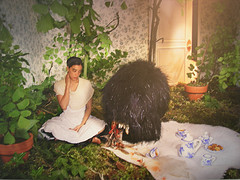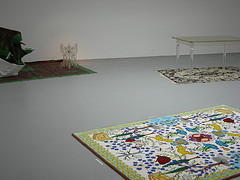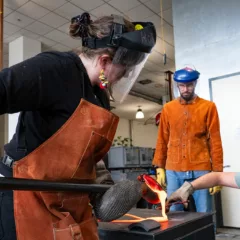Post by Andrea Kirsh
A Philadelphian in Amsterdam
I was staying in the Pijp, the neighborhood of 19th-century worker housing that was built around the Heineken brewery. Lying just outside the central ring of canals, it has a large number of immigrants and is the site of a daily market on the Albert Cuyp Straat, selling everything from fish and flowers to clothes. It was not a chic neighborhood, at least until now. It’s a bit like Old City, Philadelphia, and seems to be moving in a similar direction. No condo towers in this area yet, although Amsterdam has more construction cranes on the skyline than Philadelphia. I’ve been visiting a friend here since 1998 and within the last two years four galleries have opened, as well as numerous fashionable restaurants. I did a tour of the galleries September 14.

Mieke Woestenburg. Masters Gallery. This and the other photos in this post are by Andrea Kirsh.
I began with Masters at Eerste Jan Steenstraat 131 (yes, most of the neighborhood streets are named after the great seventeenth century masters). They are showing two recent graduates of the Rietveld Academy, Nadine Hottenrott and Mieke Woestenburg through Oct. 7. Woestenburg’s work received complaints from the neighbors on this otherwise thoroughly residential street, and the ensuing discussions with the police (the work remains on view through the large picture windows) received some press coverage. It’s a shame that it focused on the contretemps because the work is a very interesting project involving gender relations and spectatorship; it also intersects with sex on the internet.

Mieke Woestenburg. Masters Gallery.
Woestenburg placed an ad on a site where middle-aged men look for younger women, explaining that she wanted men who were willing to be photographed nude. She placed each man on a bed in a bare room, allowed him to choose his position then altered it slightly. The photographs are large, but have none of the sensuous self-display of John Coplans’ work. Nor is there any erotic tension; these are very ordinary men, slightly awkward, who might be waiting for the nurse to bring their hospital gowns. The full-scale exposure of one mans’ paunch and hairy back or another’s white legs and flaccid penis could hardly feed the ego of the most self-delusional of her subjects. Knowing how she found her sitters, I’m curious how the men reacted after the artist put her camera away. As M. Segal, the dealer, said of the work’s nudity “they’re just penises, nothing pornographic.“ He wouldn’t mind his own small children seeing them, but it’s impossible to imagine any gallery in a comparable U.S. neighborhood showing them in the windows. Americans are so uncomfortable with our bodies.
Nadine Hottenrott, born and raised in Germany, is fascinated by the artifacts that German housewives used to create homey surroundings during the 1950s, and presumably the evasion that entailed in facing Germany’s pre-war past. She exhibited one crocheted valence, of the sort commonly seen in middle-class windows, with the name of a WWII bomb worked across it. On the floor were patterns for variants with the names of other bombs and on an adjacent wall a photograph of the valence in a window. One can purchase the valence, or the pattern – and crochet it at home. Do-it-your-self political criticism.
Two blocks away, at Gerard Doustrat 142-44 is a two-artist exhibition at Dubbelbee Galerie, through Oct. 19. Photographs by Choki Lindberg, a Dane who also recently graduated from the Rietveld Acadeny, hung in the entrance area. The Netherlands has numerous art schools which attract international students (another similarity to Philadelphia). Some of them stay on in the city, while others maintain their ties here. Lindberg created fantastic and theatrical environments in which she photographed herself, altered by a good deal of make-up and Photo-Shop.

Choki Lindberg at Dubbelbee Galerie
In one she is the lead singer with a back-up group of giant cockroaches. In another she sits at a picnic gone wrong – a huge and hairy but otherwise un-definable being beside her is regurgitating its meal. She’s prettier than Cindy Sherman, but while the photographs hold some amusement value, I’m not otherwise sure what the point is.

Kuri Yorigami, detail of rug, at Dubbelbee Gallery
In the main gallery of Dubblebee’s space is an installation, “Fox hole in a handbag” by Kuri Yorigami, a Japanese artist who has spent time both in Paris and Amsterdam. Yorigami says her work refers to Alice in Wonderland and the idea that there is an unseen story behind our everyday domestic lives. The work seems rather to reflect her own horror at the domestic.

Kuri Yorigami installation at Dubbelbee Galerie
A paisley tablecloth is spread on the floor in the far corner; another cloth, folded like giant origami sits atop it, as does an up-ended crystal chandelier. A cast Lucite table is on a rug in the center of the room; on close view the table reveals tracks from worms and the rug beneath it is similarly moth-eaten. The beautifully-made carpet at the entrance looks at first glance like a traditional Persian design, but close inspection reveals various intruders: rats, and cougars attacking garbage. Yorigami has hung photographs of landscapes and interiors on the walls; some appear to be records of a performance, but their relationship to the installation was particularly unclear.
I would have missed Galerie Juliette Jongma, across the street at Gerard Douplein 23 if I hadn’t been told to look for it. There was no sign, and nothing to distinguish its curtained window with a bowl of fruit from the surrounding houses. That’s the way Donna Huddleston, an Australian artist living in London wanted it. She titled the exhibition “Summer House,” (on through Oct. 21) and considers it an installation, even though the individual parts are offered separately, down to the ceramic and wax fruit which is editioned.
The yellow-painted walls are hung with delicate watercolors and a screen divides the small area into two spaces. The small paintings, with detailed pencil designs visible through light washes of color, depict multiple figures in front of fragments of what look like Las Vegas stage-show sets. They have an implied narrative that is impossible to discern. Names such as “Dream Brothers” and “The Pretender” only further the sense that something is happening, if only we knew what.

Donna Huddleston
Here’s another artist interested in the domestic –- well, the Dutch famously value the “gezellig” (cosy, homey) and Amsterdam has more stores selling home furnishings and household goods than any city I know. But Huddleston has no Dutch connections, prior to this show. Are all these artists questioning the middle-class retreat into the personal, in the face of unending horror in the international news?

Art installation at Zus Kunstwinkel.
One final stop at a different sort of place: Zus Kunstwinkel (Sisters Art-shop), which opened at Gerard Doustraat 80 on July 1. I spoke with one of the sisters, who’s a designer (the other is an artist). They wanted to create an atmosphere that was more populist and approachable than the traditional gallery, and Zus is a combination gallery/boutique/coffee bar. The weather is exceptionally warm, so the entire front of the space is open to the street, with chairs on the sidewalk. With artist’s buttons starting at one Euro fifty it is obviously targeted at a young clientele. All of the work is limited production, mostly by young Dutch artists and designers, although when I admired a case of amusing jewelry (bracelets made of plastic mice, a necklace of tiny ceramic Dutch clogs of the sort sold in tourist shops) it turned out the designer, Ineke Otte, had been working for twenty-five years and had a hard-cover monograph documenting her production. Zus Kunstwinkel reminded me a bit of the skateboard-shop-cum-art-emporium on 4th St. south of South St. in Philadelphia, minus the skateboards. “I’ll be curious to know whether they succeed in their enterprise; It sounds like something that might do well on South Street.
–Andrea Kirsh is an art historian living in Philadelphia.









